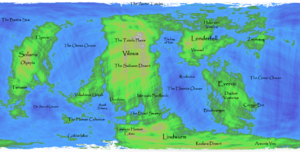Setting:Unified Setting


The Unified Setting for /tg/ is a project headed by a group of anons that aims to make the best campaign setting possible for /tg/. It is currently being prepared for both 3.5e and 4e Dungeons and Dragons and includes a number of /tg/'s favorite things.
Click on the map for a better idea.
Geographical Regions
Everoc
- Diadem Vosterus
- Blodsvargen
- Corgyn'Bre
Londerfell
- Vanawil
- Heloraen Vosilea
- Zirnitraog
Solaris
- Olympia
- Elysia
- Tartarus
Vilous
- Tatola Plains
- Sailzane Desert
- Vekshimar Uresh
- Mensala Badlands
Lindwurm
- Arsonis Vex
- Kudara Desert
Other
- Rodentia
- Goblin Isles
- Dead Swamp
Seas and Oceans
- The Great Ocean
- The Onras Ocean
- The Ebentis Ocean
- The Bastia Sea
- Arash Shkeva
- Bay of Rain
- Sea of Ghosts
Political Regions
Everoc
- Dwarven Lordships
- Diadem Vosterus
- Blodsvargen
- Corgyn'Bre
Londerfell
- The Elven Kingdom (Vanawil)
- The Drow City-States (Zirnitraog)
Solaris
- Federated Kingdoms of Solaris
- Solus – central authority of the Federation. A land of many districts ruled by noble knights and their great King. The capital of Invicta is a monumental fortress-city built in a vast lake formed in an extinct volcano.
- Vyntril – coastal democratic state flourishing on naval trade. Looking to expand their territories in the nearby marshlands and the Human Colonies.
- Baetica – a collection of several dozen farmsteads, towns and ports under a loose pseudo-communist leadership. Happily overproduce essential goods for the rest of the Federation in exchange for exotic imports from Vyntril.
- Gorgossa – militaristic state resentful of membership in the alliance. They wish to expand their holdings in various regions but are currently restrained by their neighbouring states. On the verge of a minor war with Vyntril over ownership of several small island chains.
- Aurelia – a theocratic authoritarian aristocracy. Smallest of the ‘major’ nations holding massive political power in the Federation and abroad.
- Thrace and Achaea – contested territories. Claimed by both Vyntril and Gorgossa. Each is a loose conglomeration of scattered settlements owned by both nations as well as independent towns and villages.
- Osroene – former province of Solus. Legislated by consensus as a neutral nation representing the individual members of the Federated Kingdoms and the foreign Elvish peoples. Under constant socio-political tension.
- Moesia – fledgling nation initially founded by Vyntril traders. Later claimed by Gorgossa and then by the Silvorian Empire. Currently an independent state under contention.
- Furnshakt – an uncivilised region of wilderness inhabited by bandits, raiders, primitive tribes and beasts.
Lindwurm
- New Burmecia
- Wandering Kobold Camps
- Lawless Human Cities
Vilous
- Silvoran Empire
- Silvorum, the Sergal Capital
- Tatola Highlands
- Sailzane Desert
- The Bay of Rain
- Jiar-jia, The Doobie Swamp
- Vekshimar Uresh
Others
- Rodentia
- Human Colonies
- Goblin Isles
Prominent Races
The Pantheon
A very rough summary of the organisation of deities and associated entities so far.
- Gods
- Amaterasu – sun goddess, commonly associated with fertility, light, life, good, etc. Mother of All. Recognised by most races under various guises, including Shiva, Pelor(?), YVHV, and other mono- and poly-theistic faiths. Personality fluctuates slightly between the different myths but almost universally accepted as a creator figure. Associated with sunlight, mirrors, the colour white and wolves.
- Amani, the Vengeful Sun. A prominent god of destruction in the pantheon of most cultures native to the continent of Lindwurm. Commonly blamed for the death of the ancient Draconian race and other acts of destruction.
- Horo, Daughter of the Sun. Goddess of fertility and prosperity. Different faiths refer to the same figure as being an aspect of the sun god, or quite often as part of the Earth due to her connection with crops and the harvest. Also sometimes named the Goddess of Wolves among other things.
- Tsukiyomi – lunar figure. As above, known under many different identities depending on racial culture. More often considered female. Not as widely recognised as a separate deity, sometimes considered an aspect of the primary god figure or another deity. Depictions vary widely.
- The Darkness. Present under various names in nearly every faith, sometimes as a malevolent natural force or as a mindless beast of chaos, sometimes as a god itself with evil connotations. Usually distinct from the monotheistic images of the ruler of Hell. Starless nights and solar eclipses are often considered bad omens.
- Demi-gods
- Aspects of nature – godlike spirits present in natural objects and places such as rivers, forests, mountains and trees. May or may not manifest themselves physically as some form of creature, mythical or mundane, or in mortal form. Typically possess great power over whatever aspect of the natural world with which they are associated. For example, a river god may have powers over running water and so forth.
- Ascended creatures – mortal beings that have, through one means or another, transcended their own mortality and inherited godlike abilities. Also includes heroic figures who are, for whatever reason, deified after death, even if they did not actually achieve godhood. An example of the latter would be Reis, mother of the Burmecian race, who is worshipped as a goddess centuries after her death.